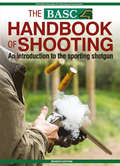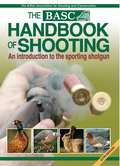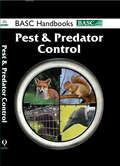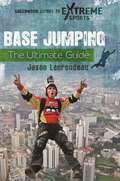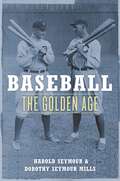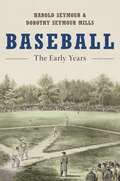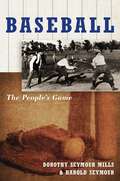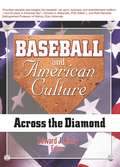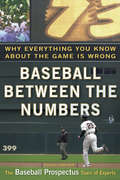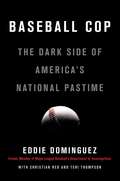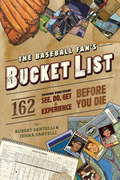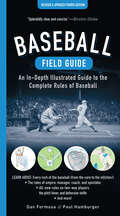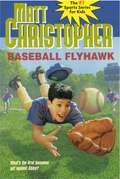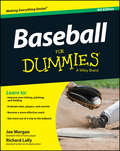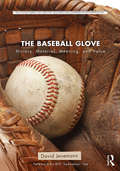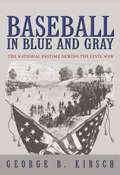- Table View
- List View
BASC Handbook of Shooting: An Introduction to the sporting shotgun (Basc Handbook Ser.)
by British Association for Shooting & ConservationThis revised Handbook of Shooting, now in its seventh edition, covers shotgun safety, the basic rules of gun handling in the field, while travelling and at home. It outlines the law as it relates to shooting and also includes chapters on behaviour in the field, the role of gundogs and the part played by gamekeepers in habitat and game management. It should be required reading for anyone who owns a sporting shotgun.
BASC Handbook of Shooting: An Introduction to the Sporting Shotgun (Basc Handbook Ser.)
by British Association for Shooting and ConservationNow in its sixth edition, extensively revised and expanded, The BASC Handbook of Shooting covers shotgun safety, the basic rules of gun handling in the field, while travelling and at home. It outlines the law as it relates to shooting and also includes chapters on behaviour in the field, the role of gundogs and the part played by gamekeepers in habitat and game management.
BASC Handbook: Pest and Predator Control
by BASCThis comprehensive and practical book, produced specifically for shoots and conservationists, provides a basic guide to all aspects of control. It explains which species can be controlled and by what means. There is detailed guidance on shooting, snaring, trapping, the use of dogs and humane dispatch. The law governing pest species is covered in detail, particularly in regard to the general licences which are frequently misunderstood, occasionally leading to prosecution. Detailed instructions are provided on the effective and legal use of snares and traps with photographic sequences to show how they should be sited and set. This will be invaluable to those who enforce wildlife law and need to distinguish between legal and illegal methods of control.
BASE Jumping: The Ultimate Guide (Greenwood Guides to Extreme Sports)
by Jason LaurendeauThis in-depth exploration of the history and culture of the sometimes illegal activity of BASE jumping provides historical and current information as well as a glimpse into the incredible adrenaline rush of the sport.BASE jumping is an extreme sport that has gained significant popularity. To date, there are over 1,400 jumpers who have earned their "BASE number," which means that they have jumped from a building, an antenna, a span, and a terrestrial point. And at least one BASE jumper is planning to attempt landing from a BASE jump without a parachute. BASE Jumping: The Ultimate Guide examines the history, subculture, and technologies associated with BASE jumping. Additionally, it considers what the relatively new expansion of this activity means within the context of how our society considers danger and risk. After an introduction, its chapters cover BASE culture and ethics, the sport's origins and current developments, techniques and equipment, sites and events, pioneering jumpers and icons of the sport, and future directions. The author—a former skydiver and BASE jumper himself—draws from careful research as well as interviews with current BASE jumpers to both provide historical context and represent the voices of those participating in the activity.
BASE Jumping: The Ultimate Guide (Greenwood Guides to Extreme Sports)
by Jason LaurendeauThis in-depth exploration of the history and culture of the sometimes illegal activity of BASE jumping provides historical and current information as well as a glimpse into the incredible adrenaline rush of the sport.BASE jumping is an extreme sport that has gained significant popularity. To date, there are over 1,400 jumpers who have earned their "BASE number," which means that they have jumped from a building, an antenna, a span, and a terrestrial point. And at least one BASE jumper is planning to attempt landing from a BASE jump without a parachute. BASE Jumping: The Ultimate Guide examines the history, subculture, and technologies associated with BASE jumping. Additionally, it considers what the relatively new expansion of this activity means within the context of how our society considers danger and risk. After an introduction, its chapters cover BASE culture and ethics, the sport's origins and current developments, techniques and equipment, sites and events, pioneering jumpers and icons of the sport, and future directions. The author—a former skydiver and BASE jumper himself—draws from careful research as well as interviews with current BASE jumpers to both provide historical context and represent the voices of those participating in the activity.
Baseball: The Golden Age
by Harold Seymour Dorothy Seymour MillsIn Baseball: The Golden Age, Harold Seymour and Dorothy Seymour Mills explore the glorious era when the game truly captured the American imagination, with such legendary figures as Babe Ruth and Ty Cobb in the spotlight. Beginning with the formation of the two major leagues in 1903, when baseball officially entered its "golden age" of popularity, the authors examine the changes in the organization of professional baseball--from an unwieldy three-man commission to the strong one-man rule of Judge Kenesaw Mountain Landis. They depicts how the play on the field shifted from the low-scoring, pitcher-dominated game of the "dead ball" era before World War I to the higher scoring of the 1920's "lively ball" era, with emphasis on home runs, best exemplified by the exploits of Babe Ruth. Note: On August 2, 2010, Oxford University Press made public that it would credit Dorothy Seymour Mills as co-author of the three baseball histories previously "authored" solely by her late husband, Harold Seymour. The Seymours collaborated on Baseball: The Early Years (1960), Baseball: The Golden Age (1971) and Baseball: The People's Game (1991).
Baseball: The Early Years
by Harold Seymour Dorothy Seymour MillsNow available in paperback, Harold Seymour and Dorothy Seymour Mills' Baseball: The Early Years recounts the true story of how baseball came into being and how it developed into a highly organized business and social institution. The Early Years, traces the growth of baseball from the time of the first recorded ball game at Valley Forge during the revolution until the formation of the two present-day major leagues in 1903. By investigating previously unknown sources, the book uncovers the real story of how baseball evolved from a gentleman's amateur sport of "well-bred play followed by well-laden banquet tables" into a professional sport where big leagues operate under their own laws. Offering countless anecdotes and a wealth of new information, the authors explode many cherished myths, including the one which claims that Abner Doubleday "invented" baseball in 1839. They describe the influence of baseball on American business, manners, morals, social institutions, and even show business, as well as depicting the types of men who became the first professional ball players, club owners, and managers, including Spalding, McGraw, Comiskey, and Connie Mack. Note: On August 2, 2010, Oxford University Press made public that it would credit Dorothy Seymour Mills as co-author of the three baseball histories previously "authored" solely by her late husband, Harold Seymour. The Seymours collaborated on Baseball: The Early Years (1960), Baseball: The Golden Age (1971) and Baseball: The People's Game (1991).
Baseball: The Early Years
by Harold Seymour Dorothy Seymour MillsNow available in paperback, Harold Seymour and Dorothy Seymour Mills' Baseball: The Early Years recounts the true story of how baseball came into being and how it developed into a highly organized business and social institution. The Early Years, traces the growth of baseball from the time of the first recorded ball game at Valley Forge during the revolution until the formation of the two present-day major leagues in 1903. By investigating previously unknown sources, the book uncovers the real story of how baseball evolved from a gentleman's amateur sport of "well-bred play followed by well-laden banquet tables" into a professional sport where big leagues operate under their own laws. Offering countless anecdotes and a wealth of new information, the authors explode many cherished myths, including the one which claims that Abner Doubleday "invented" baseball in 1839. They describe the influence of baseball on American business, manners, morals, social institutions, and even show business, as well as depicting the types of men who became the first professional ball players, club owners, and managers, including Spalding, McGraw, Comiskey, and Connie Mack. Note: On August 2, 2010, Oxford University Press made public that it would credit Dorothy Seymour Mills as co-author of the three baseball histories previously "authored" solely by her late husband, Harold Seymour. The Seymours collaborated on Baseball: The Early Years (1960), Baseball: The Golden Age (1971) and Baseball: The People's Game (1991).
Baseball: The Golden Age
by Harold Seymour Dorothy Seymour MillsIn Baseball: The Golden Age, Harold Seymour and Dorothy Seymour Mills explore the glorious era when the game truly captured the American imagination, with such legendary figures as Babe Ruth and Ty Cobb in the spotlight. Beginning with the formation of the two major leagues in 1903, when baseball officially entered its "golden age" of popularity, the authors examine the changes in the organization of professional baseball--from an unwieldy three-man commission to the strong one-man rule of Judge Kenesaw Mountain Landis. They depicts how the play on the field shifted from the low-scoring, pitcher-dominated game of the "dead ball" era before World War I to the higher scoring of the 1920's "lively ball" era, with emphasis on home runs, best exemplified by the exploits of Babe Ruth. Note: On August 2, 2010, Oxford University Press made public that it would credit Dorothy Seymour Mills as co-author of the three baseball histories previously "authored" solely by her late husband, Harold Seymour. The Seymours collaborated on Baseball: The Early Years (1960), Baseball: The Golden Age (1971) and Baseball: The People's Game (1991).
Baseball: The People's Game
by Harold Seymour Dorothy Seymour MillsIn Baseball: The People's Game, Dorothy Seymour Mills and Harold Seymour produce an authoritative, multi-volume chronicle of America's national pastime. The first two volumes of this study -The Early Years and The Golden Age -won universal acclaim. The New York Times wrote that they "will grip every American who has invested part of his youth and dreams in the sport," while The Boston Globe called them "irresistible." Now, in The People's Game, the authors offer the first book devoted entirely to the history of the game outside of the professional leagues, revealing how, from its early beginnings up to World War II, baseball truly became the great American pastime. They explore the bond between baseball and boys through the decades, the game's place in institutions from colleges to prisons to the armed forces, the rise of women's baseball that coincided with nineteenth century feminism, and the struggles of black players and clubs from the later years of slavery up to the Second World War. Whether discussing the birth of softball or the origins of the seventh inning stretch, the Seymours enrich their extensive research with fascinating details and entertaining anecdotes as well as a wealth of baseball experience. The People's Game brings to life the central role of baseball for generations of Americans. Note: On August 2, 2010, Oxford University Press made public that it would credit Dorothy Seymour Mills as co-author of the three baseball histories previously "authored" solely by her late husband, Harold Seymour. The Seymours collaborated on Baseball: The Early Years (1960), Baseball: The Golden Age (1971) and Baseball: The People's Game (1991).
Baseball: The People's Game
by Dorothy Seymour Mills Harold SeymourIn Baseball: The People's Game, Dorothy Seymour Mills and Harold Seymour produce an authoritative, multi-volume chronicle of America's national pastime. The first two volumes of this study -The Early Years and The Golden Age -won universal acclaim. The New York Times wrote that they "will grip every American who has invested part of his youth and dreams in the sport," while The Boston Globe called them "irresistible." Now, in The People's Game, the authors offer the first book devoted entirely to the history of the game outside of the professional leagues, revealing how, from its early beginnings up to World War II, baseball truly became the great American pastime. They explore the bond between baseball and boys through the decades, the game's place in institutions from colleges to prisons to the armed forces, the rise of women's baseball that coincided with nineteenth century feminism, and the struggles of black players and clubs from the later years of slavery up to the Second World War. Whether discussing the birth of softball or the origins of the seventh inning stretch, the Seymours enrich their extensive research with fascinating details and entertaining anecdotes as well as a wealth of baseball experience. The People's Game brings to life the central role of baseball for generations of Americans. Note: On August 2, 2010, Oxford University Press made public that it would credit Dorothy Seymour Mills as co-author of the three baseball histories previously "authored" solely by her late husband, Harold Seymour. The Seymours collaborated on Baseball: The Early Years (1960), Baseball: The Golden Age (1971) and Baseball: The People's Game (1991).
Baseball and American Culture: Across the Diamond
by Frank Hoffmann Edward J Rielly Martin J ManningDiscover baseball's role in American society! Baseball and American Culture: Across the Diamond is a thoughtful look at baseball's impact on American society through the eyes of the game's foremost scholars, historians, and commentators. Edited by Dr. Edward J. Rielly, author of Baseball: An Encyclopedia of Popular Culture, the book examines how baseball and society intersect and interact, and how the quintessential American game reflects and affects American culture. Enlightening and entertaining, Baseball and American Culture presents a multidisciplinary perspective on baseball's involvement in virtually every important social development in the United States-past and present. Baseball and American Culture examines baseball&’s unique role as a sociological touchstone, presenting scholarly essays that explore the game as a microcosm for American society-good and bad. Topics include the struggle for racial equality, women&’s role in society, immigration, management-labor conflicts, advertising, patriotism, religion, the limitations of baseball as a metaphor, and suicide. Contributing authors include Larry Moffi, author of This Side of Cooperstown: An Oral History of Major League Baseball in the 1950s and Crossing the Line: Black Major Leaguers, 1947-1959, and a host of presenters to the 2001 Cooperstown Symposium on Baseball and American Culture, including Thomas Altherr, George Grella, Dave Ogden, Roberta Newman, Brian Carroll, Richard Puerzer, and the editor himself. Baseball and American Culture features 23 essays on this fascinating subject, including: "On Fenway, Faith, and Fandom: A Red Sox Fan Reflects" "Baseball and Blacks: A Loss of Affinity, A Loss of Community" "The Hall of Fame and the American Mythology" "Writing Their Way Home: American Writers and Baseball" "God and the Diamond: The Born-Again Baseball Autobiography" Baseball and American Culture: Across the Diamond is an essential read for baseball fans and historians, academics involved in sports literature and popular culture, and students of American society.
Baseball and American Culture: Across the Diamond
by Frank Hoffmann Edward J Rielly Martin J ManningDiscover baseball's role in American society! Baseball and American Culture: Across the Diamond is a thoughtful look at baseball's impact on American society through the eyes of the game's foremost scholars, historians, and commentators. Edited by Dr. Edward J. Rielly, author of Baseball: An Encyclopedia of Popular Culture, the book examines how baseball and society intersect and interact, and how the quintessential American game reflects and affects American culture. Enlightening and entertaining, Baseball and American Culture presents a multidisciplinary perspective on baseball's involvement in virtually every important social development in the United States-past and present. Baseball and American Culture examines baseball&’s unique role as a sociological touchstone, presenting scholarly essays that explore the game as a microcosm for American society-good and bad. Topics include the struggle for racial equality, women&’s role in society, immigration, management-labor conflicts, advertising, patriotism, religion, the limitations of baseball as a metaphor, and suicide. Contributing authors include Larry Moffi, author of This Side of Cooperstown: An Oral History of Major League Baseball in the 1950s and Crossing the Line: Black Major Leaguers, 1947-1959, and a host of presenters to the 2001 Cooperstown Symposium on Baseball and American Culture, including Thomas Altherr, George Grella, Dave Ogden, Roberta Newman, Brian Carroll, Richard Puerzer, and the editor himself. Baseball and American Culture features 23 essays on this fascinating subject, including: "On Fenway, Faith, and Fandom: A Red Sox Fan Reflects" "Baseball and Blacks: A Loss of Affinity, A Loss of Community" "The Hall of Fame and the American Mythology" "Writing Their Way Home: American Writers and Baseball" "God and the Diamond: The Born-Again Baseball Autobiography" Baseball and American Culture: Across the Diamond is an essential read for baseball fans and historians, academics involved in sports literature and popular culture, and students of American society.
Baseball Between the Numbers: Why Everything You Know About the Game Is Wrong
by Jonah Keri Baseball ProspectusIn the numbers-obsessed sport of baseball, statistics don't merely record what players, managers, and owners have done. Properly understood, they can tell us how the teams we root for could employ better strategies, put more effective players on the field, and win more games. The revolution in baseball statistics that began in the 1970s is a controversial subject that professionals and fans alike argue over without end. Despite this fundamental change in the way we watch and understand the sport, no one has written the book that reveals, across every area of strategy and management, how the best practitioners of statistical analysis in baseball-people like Bill James, Billy Beane, and Theo Epstein-think about numbers and the game. Baseball Between the Numbers is that book. In separate chapters covering every aspect of the game, from hitting, pitching, and fielding to roster construction and the scouting and drafting of players, the experts at Baseball Prospectus examine the subtle, hidden aspects of the game, bring them out into the open, and show us how our favorite teams could win more games. This is a book that every fan, every follower of sports radio, every fantasy player, every coach, and every player, at every level, can learn from and enjoy.
Baseball Cop
by Eddie DominguezExposing trafficking, theft, fraud, and gambling in the major leagues, a founding member of the MLB's Department of Investigations reveals a news-breaking true story of power and corruption. In the wake of 2005's sometimes contentious, sometimes comical congressional hearings on performance-enhancing drugs in baseball and the subsequent Mitchell Report, Major League Baseball established the Department of Investigations (DOI). An internal and autonomous unit, it was created to not only eliminate the use of steroids, but also to rid baseball of any other illegal, unsavory, or unethical activities. The DOI would investigate the dark side of the national pastime--gambling, age and identity fraud, human trafficking, cover-ups, and more--with the singular purpose of cleaning up the game. Eduardo Dominguez Jr. was a founding member of that first DOI team, leaving a stellar career with the Boston Police Department to join four other "supercops"--a group that included a 9/11 hero, a mob-buster, and narcotics experts--keeping watch over Major League Baseball. A decorated detective as well as a member of an FBI task force, Dominguez was initially reluctant to leave his law-enforcement career to work full-time in baseball. He had already seen the game's underbelly when he worked as a resident security agent (RSA) for the Boston Red Sox in 1999 and become wary of the game's commitment to any kind of reform. Only at the persuasion a widely respected NYPD detective tapped to lead the DOI did Dominguez agree to join the unit, which was the first--and last--of its kind in major American sports. "We could clean up this game," his new boss promised. In Baseball Cop, Dominguez shares the shocking revelations he confronted every day for six years with the DOI and nine as an RSA. He shines a light on the inner workings of the commissioner's office and the complicity of baseball's bosses in dealing with the misdeeds compromising the integrity of the game. Dominguez details the investigations and the obstacles--from the Biogenesis scandal to the perilous trafficking of Cuban players now populating the game to the theft of prospects' signing bonuses by buscones, street agents, and even clubs' employees. He further reveals how the mandates of former senator George Mitchell's report were modified or ignored altogether. Bracing and eye-opening, Baseball Cop is a wake-up call for anyone concerned about America's national pastime.
The Baseball Fan's Bucket List: 162 Things You Must Do, See, Get, and Experience Before You Die
by Robert Santelli Jenna SantelliNo sports fans are more in touch with the history and ephemera of their game than baseball fans. Hitting the sweet spot of our national pastime, The Baseball Fans Bucket List presents a list of 162 absolute must things to do, see, get, and experience before you kick the bucket. Entries range from visiting Elysian Fields in Hoboken, NJ (site of the first pro baseball game), to starting a baseball card collection; experiencing Opening Day; attending your favorite teams Fantasy Camp; reading classic books like Ball Four, and much more! Each entry includes interesting facts, entertaining trivia, and practical information about the activity, item, or travel destination. Also included is a complete checklist so the reader can keep a running tally of their Bucket-List achievements. With todays tabloid stories of steroid abuse and off-the-field shenanigans encroaching on baseballs idyllic charm, this unique guidebook encourages readers to celebrate all thats good about being a fan.
The Baseball Fan's Bucket List: 162 Things You Must Do, See, Get, and Experience Before You Die
by Robert Santelli Jenna SantelliNo sports fans are more in touch with the history and ephemera of their game than baseball fans. Hitting the sweet spot of our national pastime, The Baseball Fans Bucket List presents a list of 162 absolute must things to do, see, get, and experience before you kick the bucket. Entries range from visiting Elysian Fields in Hoboken, NJ (site of the first pro baseball game), to starting a baseball card collection; experiencing Opening Day; attending your favorite teams Fantasy Camp; reading classic books like Ball Four, and much more! Each entry includes interesting facts, entertaining trivia, and practical information about the activity, item, or travel destination. Also included is a complete checklist so the reader can keep a running tally of their Bucket-List achievements. With todays tabloid stories of steroid abuse and off-the-field shenanigans encroaching on baseballs idyllic charm, this unique guidebook encourages readers to celebrate all thats good about being a fan.
Baseball Field Guide, Fourth Edition: An In-Depth Illustrated Guide to the Complete Rules of Baseball
by Dan Formosa Paul HamburgerA great overview for novices and a precise reference guide for devoted fans!Admit it: Even if you&’re a die-hard fan of our national pastime, sometimes an umpire's call can be baffling. And for newer fans, Major League Baseball's nuanced rules—developed and revised over many decades—can be downright perplexing. Now updated throughout with the latest changes, including specifications about the universal designated hitter and limits on defensive shifts, the Baseball Field Guide lays out every rule in plain English. You&’ll learn to answer all these questions and more: Do you know the twenty-two ways a pitcher can be charged with a balk? Can you list all seven ways a batter can safely get to first base? Obstruction or interference—who&’s at fault when things get rough? What are the rules that apply before and after a game? What happens when spectators are the ones who misbehave? How well do you understand the infamous Infield Fly Rule (and why does it exist)? This is the clearest explanation anywhere of the rules of baseball. Designed for quick and intuitive searches, this entertaining reference will help you understand every aspect of the game and add to your enjoyment of the sport.
Baseball Flyhawk
by Matt ChristopherChico Romez is new to the Royals baseball team, but all the players welcome him and his ability in the outfield. All but one, that its. String Becker seems to have it in for Chico. What will it take for Chico to prove himself to String?
Baseball For Dummies
by Joe Morgan Richard LallyPlay, watch, and understand America's favorite pastime Baseball continues to be a popular game both as a spectator sport and as a pastime. Since the publication of Baseball For Dummies, 3rd Edition, baseball teams have changed, new MLB stadiums have been built, and rules have been updated. This updated 4th Edition brings you the latest information on the players, the places, and above all, the game. Baseball For Dummies is for baseball fans at all levels, from players and coaches to spectators who love the game. Baseball Hall of Fame player Joe Morgan explains baseball with remarkable insight, using down-to-earth language so everyone from the casual observer to the die-hard fan can gain a fuller appreciation of the sport. Improve your hitting, pitching, and fielding Find a baseball team to play on, from Little League on up Evaluate stats, players, and records Coach baseball or umpire effectively Get more out of a trip to the ballpark The latest on baseball stats and sabermetrics Complete with Morgan's personal lists of top-ten toughest pitchers, smartest players, and most strategic managers, Baseball For Dummies gives you all the inside tips, facts, and stats so you can have Major League fun!
Baseball For Dummies
by Joe Morgan Richard LallyPlay, watch, and understand America's favorite pastime Baseball continues to be a popular game both as a spectator sport and as a pastime. Since the publication of Baseball For Dummies, 3rd Edition, baseball teams have changed, new MLB stadiums have been built, and rules have been updated. This updated 4th Edition brings you the latest information on the players, the places, and above all, the game. Baseball For Dummies is for baseball fans at all levels, from players and coaches to spectators who love the game. Baseball Hall of Fame player Joe Morgan explains baseball with remarkable insight, using down-to-earth language so everyone from the casual observer to the die-hard fan can gain a fuller appreciation of the sport. Improve your hitting, pitching, and fielding Find a baseball team to play on, from Little League on up Evaluate stats, players, and records Coach baseball or umpire effectively Get more out of a trip to the ballpark The latest on baseball stats and sabermetrics Complete with Morgan's personal lists of top-ten toughest pitchers, smartest players, and most strategic managers, Baseball For Dummies gives you all the inside tips, facts, and stats so you can have Major League fun!
The Baseball Glove: History, Material, Meaning, and Value (Routledge Series for Creative Teaching and Learning in Anthropology)
by David JenemannThe baseball glove is a ubiquitous item, a crucial piece of equipment in the game of baseball, and it offers the opportunity to examine the production of material culture and social practice at numerous levels. Where and how is a glove made, and how does its manufacture square with the narratives surrounding its place in American cultural life? What are the myths, superstitions, and beliefs surrounding its acquisition, care, use, and significance? How does a glove function as the center of a web of cultural practices that illustrate how individuals relate to a consumer good as a symbol of memory, personal narrative, and national identity? How do the manufacturers of baseball gloves draw upon, promote, and in some sense create these practices? How do these practices and meanings change in other national and cultural contexts? The Baseball Glove offers students the opportunity to examine these questions in an engagingly written and illustrated book that promotes hands-on interaction with a quintessential item of material culture. At the same time, the book gives students the space for critical self-reflection about the place of material goods like sporting equipment in their lives, and it provides the chance to learn different methodological approaches to studying everyday objects.
The Baseball Glove: History, Material, Meaning, and Value (Routledge Series for Creative Teaching and Learning in Anthropology)
by David JenemannThe baseball glove is a ubiquitous item, a crucial piece of equipment in the game of baseball, and it offers the opportunity to examine the production of material culture and social practice at numerous levels. Where and how is a glove made, and how does its manufacture square with the narratives surrounding its place in American cultural life? What are the myths, superstitions, and beliefs surrounding its acquisition, care, use, and significance? How does a glove function as the center of a web of cultural practices that illustrate how individuals relate to a consumer good as a symbol of memory, personal narrative, and national identity? How do the manufacturers of baseball gloves draw upon, promote, and in some sense create these practices? How do these practices and meanings change in other national and cultural contexts? The Baseball Glove offers students the opportunity to examine these questions in an engagingly written and illustrated book that promotes hands-on interaction with a quintessential item of material culture. At the same time, the book gives students the space for critical self-reflection about the place of material goods like sporting equipment in their lives, and it provides the chance to learn different methodological approaches to studying everyday objects.
Baseball in Blue and Gray: The National Pastime during the Civil War
by George B. KirschDuring the Civil War, Americans from homefront to battlefront played baseball as never before. While soldiers slaughtered each other over the country's fate, players and fans struggled over the form of the national pastime. George Kirsch gives us a color commentary of the growth and transformation of baseball during the Civil War. He shows that the game was a vital part of the lives of many a soldier and civilian--and that baseball's popularity had everything to do with surging American nationalism. By 1860, baseball was poised to emerge as the American sport. Clubs in northeastern and a few southern cities played various forms of the game. Newspapers published statistics, and governing bodies set rules. But the Civil War years proved crucial in securing the game's place in the American heart. Soldiers with bats in their rucksacks spread baseball to training camps, war prisons, and even front lines. As nationalist fervor heightened, baseball became patriotic. Fans honored it with the title of national pastime. War metaphors were commonplace in sports reporting, and charity games were scheduled. Decades later, Union general Abner Doubleday would be credited (wrongly) with baseball's invention. The Civil War period also saw key developments in the sport itself, including the spread of the New York-style of play, the advent of revised pitching rules, and the growth of commercialism. Kirsch recounts vivid stories of great players and describes soldiers playing ball to relieve boredom. He introduces entrepreneurs who preached the gospel of baseball, boosted female attendance, and found new ways to make money. We witness bitterly contested championships that enthralled whole cities. We watch African Americans embracing baseball despite official exclusion. And we see legends spring from the pens of early sportswriters. Rich with anecdotes and surprising facts, this narrative of baseball's coming-of-age reveals the remarkable extent to which America's national pastime is bound up with the country's defining event.
Baseball in Blue and Gray: The National Pastime during the Civil War (PDF)
by George B. KirschDuring the Civil War, Americans from homefront to battlefront played baseball as never before. While soldiers slaughtered each other over the country's fate, players and fans struggled over the form of the national pastime. George Kirsch gives us a color commentary of the growth and transformation of baseball during the Civil War. He shows that the game was a vital part of the lives of many a soldier and civilian--and that baseball's popularity had everything to do with surging American nationalism. By 1860, baseball was poised to emerge as the American sport. Clubs in northeastern and a few southern cities played various forms of the game. Newspapers published statistics, and governing bodies set rules. But the Civil War years proved crucial in securing the game's place in the American heart. Soldiers with bats in their rucksacks spread baseball to training camps, war prisons, and even front lines. As nationalist fervor heightened, baseball became patriotic. Fans honored it with the title of national pastime. War metaphors were commonplace in sports reporting, and charity games were scheduled. Decades later, Union general Abner Doubleday would be credited (wrongly) with baseball's invention. The Civil War period also saw key developments in the sport itself, including the spread of the New York-style of play, the advent of revised pitching rules, and the growth of commercialism. Kirsch recounts vivid stories of great players and describes soldiers playing ball to relieve boredom. He introduces entrepreneurs who preached the gospel of baseball, boosted female attendance, and found new ways to make money. We witness bitterly contested championships that enthralled whole cities. We watch African Americans embracing baseball despite official exclusion. And we see legends spring from the pens of early sportswriters. Rich with anecdotes and surprising facts, this narrative of baseball's coming-of-age reveals the remarkable extent to which America's national pastime is bound up with the country's defining event.
